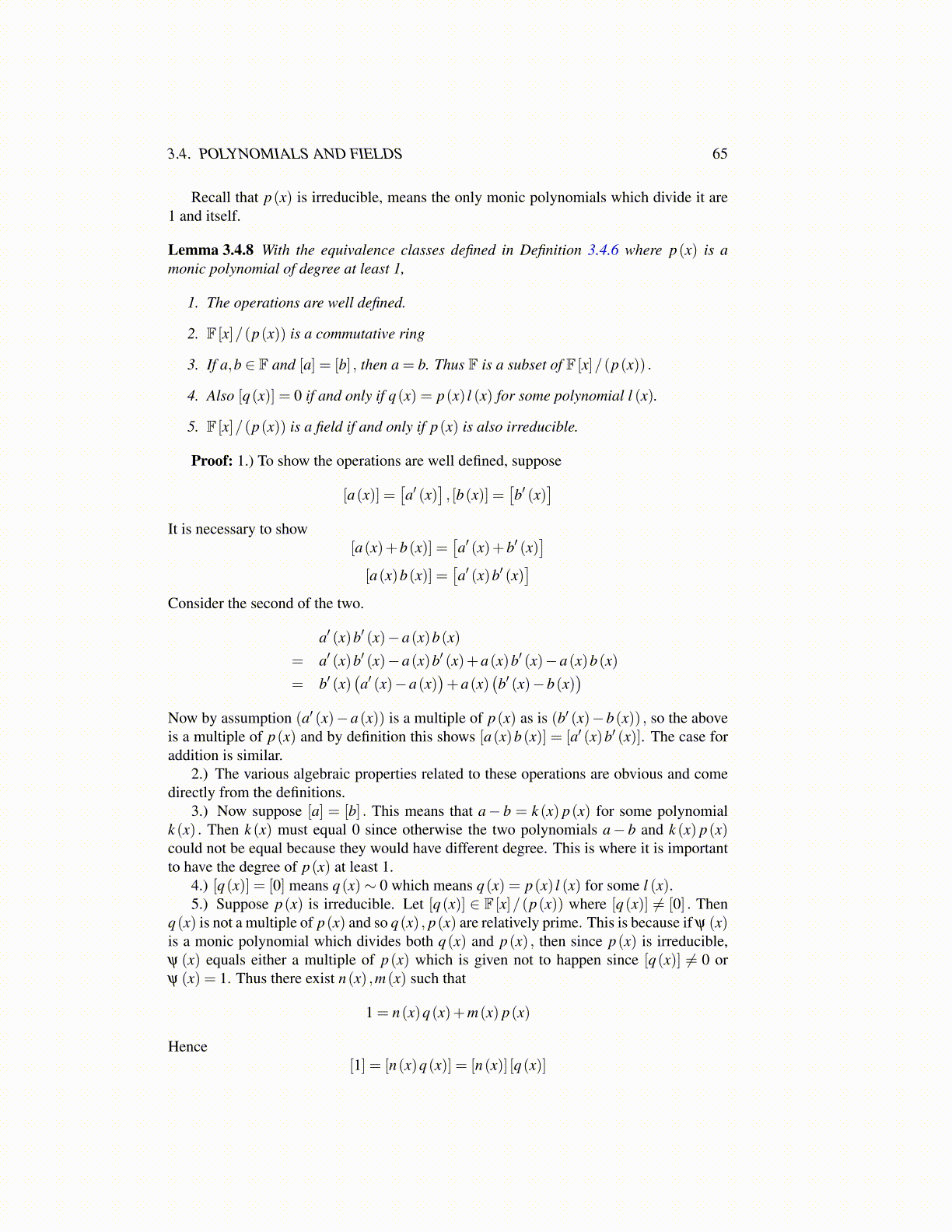
3.4. POLYNOMIALS AND FIELDS 65
Recall that p(x) is irreducible, means the only monic polynomials which divide it are1 and itself.
Lemma 3.4.8 With the equivalence classes defined in Definition 3.4.6 where p(x) is amonic polynomial of degree at least 1,
1. The operations are well defined.
2. F [x]/(p(x)) is a commutative ring
3. If a,b ∈ F and [a] = [b] , then a = b. Thus F is a subset of F [x]/(p(x)) .
4. Also [q(x)] = 0 if and only if q(x) = p(x) l (x) for some polynomial l (x).
5. F [x]/(p(x)) is a field if and only if p(x) is also irreducible.
Proof: 1.) To show the operations are well defined, suppose
[a(x)] =[a′ (x)
], [b(x)] =
[b′ (x)
]It is necessary to show
[a(x)+b(x)] =[a′ (x)+b′ (x)
][a(x)b(x)] =
[a′ (x)b′ (x)
]Consider the second of the two.
a′ (x)b′ (x)−a(x)b(x)
= a′ (x)b′ (x)−a(x)b′ (x)+a(x)b′ (x)−a(x)b(x)
= b′ (x)(a′ (x)−a(x)
)+a(x)
(b′ (x)−b(x)
)Now by assumption (a′ (x)−a(x)) is a multiple of p(x) as is (b′ (x)−b(x)) , so the aboveis a multiple of p(x) and by definition this shows [a(x)b(x)] = [a′ (x)b′ (x)]. The case foraddition is similar.
2.) The various algebraic properties related to these operations are obvious and comedirectly from the definitions.
3.) Now suppose [a] = [b] . This means that a− b = k (x) p(x) for some polynomialk (x) . Then k (x) must equal 0 since otherwise the two polynomials a− b and k (x) p(x)could not be equal because they would have different degree. This is where it is importantto have the degree of p(x) at least 1.
4.) [q(x)] = [0] means q(x)∼ 0 which means q(x) = p(x) l (x) for some l (x).5.) Suppose p(x) is irreducible. Let [q(x)] ∈ F [x]/(p(x)) where [q(x)] ̸= [0] . Then
q(x) is not a multiple of p(x) and so q(x) , p(x) are relatively prime. This is because if ψ (x)is a monic polynomial which divides both q(x) and p(x) , then since p(x) is irreducible,ψ (x) equals either a multiple of p(x) which is given not to happen since [q(x)] ̸= 0 orψ (x) = 1. Thus there exist n(x) ,m(x) such that
1 = n(x)q(x)+m(x) p(x)
Hence[1] = [n(x)q(x)] = [n(x)] [q(x)]